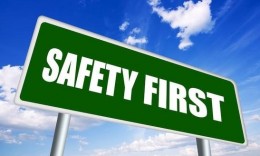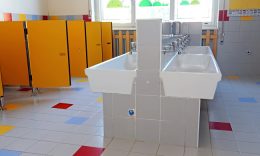12 Questions to Ask When Creating a Safety Plan

As a leader in a child-centered organization, one of your most significant responsibilities is providing a safe environment for kids, youth, and staff. Regardless of your children’s area size, it’s best to have a safety plan in place. A safety plan is a preparatory approach that combines all the strategic processes and programs that help reduce risk, minimize accidents and injury, offer ongoing training and education, follow standards, and respond to emergencies.
Whether creating one for the first time or updating one made years ago, here are twelve questions to get you started. These questions will help you focus on the needed actions that increase safety, prepare your organization for an unforeseen event, and bring together all your policy and guidelines under one repository.
1. Do you have a check-In & out process?
An effective check-in and out process provides more than just attendance tracking. Whether you use an electronic solution or another method, it is vital to improve safety. To secure your children’s area, you need to have accurate records of who is checking in and out, know who is and is not authorized to pick up children and have quick access to your data.
2. What are your current policies?
Does a child protection policy exist? If so, what does it say? Review the policy in relation to your organization and how it functions today. Should it be updated or newly created? If there have not been any incidents and volunteers and staff follow proper protocols, check it off the list.
3. What are you doing to build a speak-up culture?
A speak-up culture improves child safety and provides an opportunity to create a safe environment. In addition, it encourages staff and volunteers to raise concerns about illegal practices or policy violations without fear of getting in trouble or retaliation.
4. What are your organization’s top risks?
Doing a regular risk assessment is a vital component of developing a good safety strategy. Your risks depend on size, location, classroom ratios, screening practices, communication, transparency, education, and leadership commitment to prioritizing child safety.
5. Is the facility design optimized for child safety?
For facility design, small changes can make a big difference. For example, evaluate factors such as visibility, access control, location of safety items, bathroom procedures and location, and threat analysis if something happens while classes are in session.
6. Are you engaging and utilizing the security team?
Working with a security team may sometimes seems improbable and out of scope for children’s area directors. However, there are significant benefits to leveraging their knowledge and expertise. Security teams can fill in the resource gaps regarding protection and safety. They should be your number one resource for incident management, conflict resolution, and evacuation procedures.
7. Are the training and education initiatives effective and practical?
Training and education will be continuous. Are activities aligned for internal and external participants, age-appropriate, and include information for volunteers, staff, leaders, and families? Are the policy updates and reminders incorporated into weekly, monthly, or quarterly meetings?
8. Is there a comprehensive screening process for all volunteers, staff, and leadership?
Comprehensive screening prevents bad behavior, protects your organization, and eliminates easy access to kids and youth. To be thorough, follow the seven essential elements to screen adults carefully.
9. Does a well-designed process to document incidents exist?
Kids are active, and bumps, bruises, and scrapes will happen. Therefore, having a process to document incidents is imperative to improve safety. Most insurance companies define an incident as “anytime an accident happens that requires the injured to stop the normal activity or receive first aid or medical attention”. A good incident report helps to reduce risk and should include photos, treatment provided, witness statements, and the steps to prevent another occurrence.
10. Is the children’s area prepared to respond to an emergency?
The worst time to prepare for an emergency is during one. Emergency preparedness should be a top priority in the age of active shooters, natural disasters, and pandemics. To respond effectively, you should have an emergency response plan in place.
11. Does your organization offer an annual safety survey?
A survey is an excellent way to gather information from families and children on what they need and expect regarding child safety. A survey helps with decision-making, improves areas that need work, and builds an open dialogue. So, we encourage organizations to consider an annual family survey and safety evaluation for the best results.
12. Would families be better served with a Child Safeguarding Committee?
Child safety is a tremendous job. To do it properly cannot be the responsibility of one person. A Child Safeguarding Committee seeks to create a safe environment for children and youth by developing and implementing safety guidelines such as the child protection policy, screening procedures, incident response, training and education requirements, and ongoing communication with the organization. In addition, they respond to abuse allegations and safety concerns in accordance with the law and insurance regulations.
Click here and join us for a free product demo and learn more about the benefits of using secure children’s check-in. Subscribe to the KidCheck Blog or join us on YouTube, Twitter, Facebook, Pinterest, and Instagram.
Photo by Marissa Grootes on Unsplash


